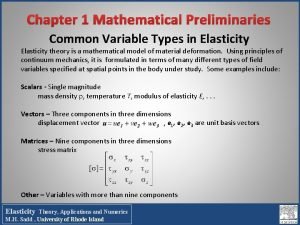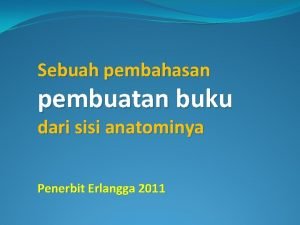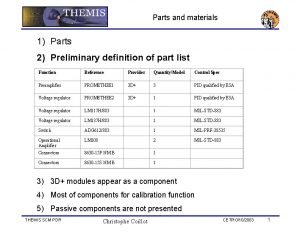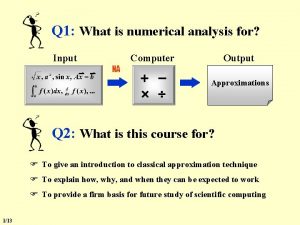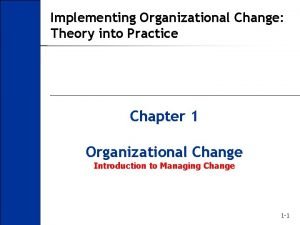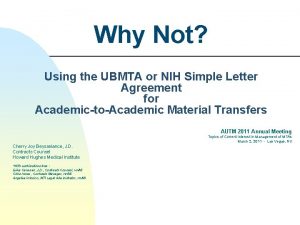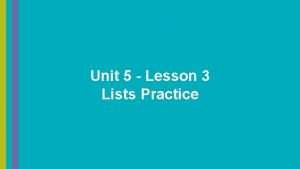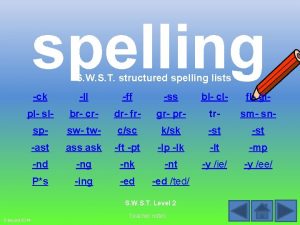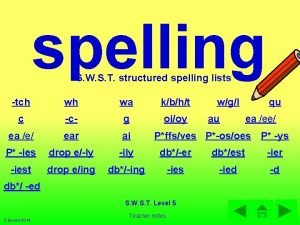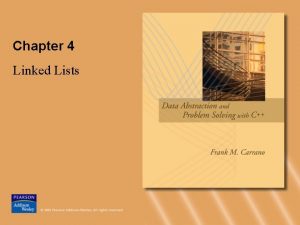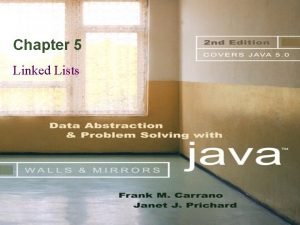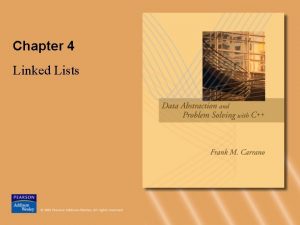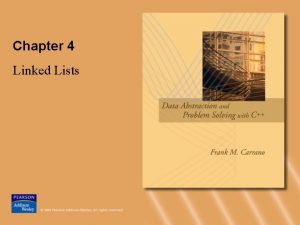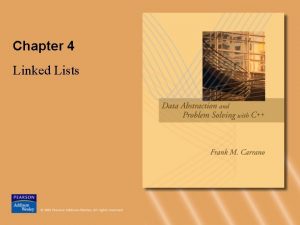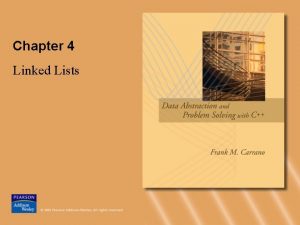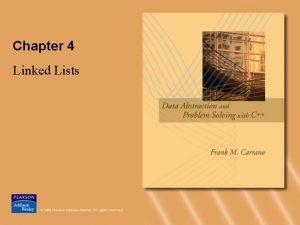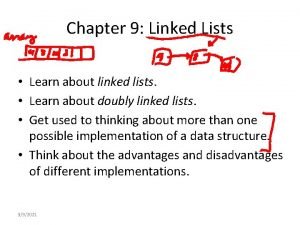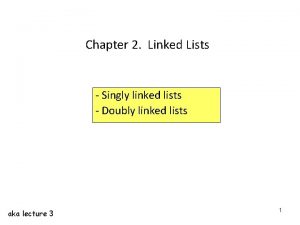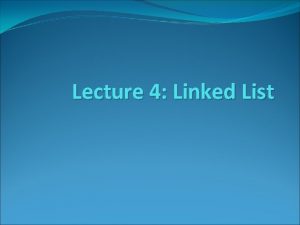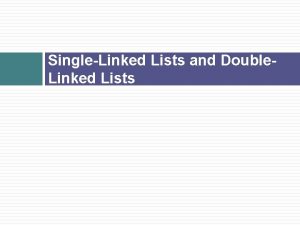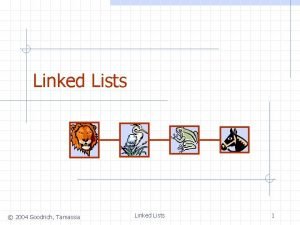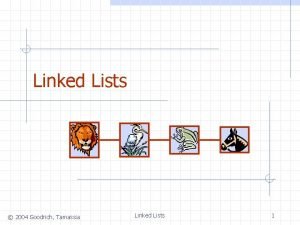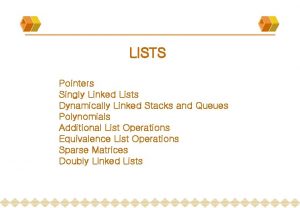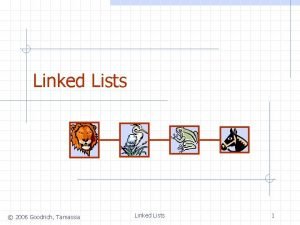Chapter 4 Linked Lists Preliminaries Options for implementing







































- Slides: 39

Chapter 4 Linked Lists

Preliminaries • Options for implementing an ADT List – Array has a fixed size • Data must be shifted during insertions and deletions – Linked list is able to grow in size as needed • Does not require the shifting of items during insertions and deletions © 2005 Pearson Addison-Wesley. All rights reserved 2

Preliminaries Figure 4. 1 a) A linked list of integers; b) insertion; c) deletion © 2005 Pearson Addison-Wesley. All rights reserved 3

Pointers • A pointer contains the location, or address in memory, of a memory cell – Initially undefined, but not NULL – A statically allocated pointer declaration int *p; – A dynamically allocated pointer variable p = new int; © 2005 Pearson Addison-Wesley. All rights reserved 4

Pointers • The expression, *p, denotes the memory cell to which p points • The & address-of operator places the address of a variable into a pointer variable – p = &x; Figure 4. 2 A pointer to an integer © 2005 Pearson Addison-Wesley. All rights reserved 5

Pointers • The delete operator returns dynamically allocated memory to the system for reuse, and leaves the variable undefined – delete p; – A pointer to a deallocated memory cell is possible and dangerous • Assign the pointer q the value in p q = p; © 2005 Pearson Addison-Wesley. All rights reserved 6

Pointers Figure 4. 3 (a) declaring pointer variables; (b) pointing to statically allocating memory; (c) assigning a value; (d) allocating memory dynamically; (e) assigning a value © 2005 Pearson Addison-Wesley. All rights reserved 7

Pointers Figure 4. 3 (f) copying a pointer; (g) allocating memory dynamically and assigning a value; (h) assigning NULL to a pointer variable; (i) deallocating memory © 2005 Pearson Addison-Wesley. All rights reserved 8

Dynamic Allocation of Arrays • Use the new operator to allocate an array dynamically • An array name is a pointer to the array’s first element • The size of a dynamically allocated array can be increased double* old. Array = an. Array; an. Array = new double[2*array. Size]; © 2005 Pearson Addison-Wesley. All rights reserved 9

Pointer-Based Linked Lists • A node in a linked list is usually a struct Node { int item Node *next; }; //end struct Figure 4. 6 A node • A node is dynamically allocated Node *p; p = new Node; © 2005 Pearson Addison-Wesley. All rights reserved 10

Pointer-Based Linked Lists • The head pointer points to the first node in a linked list • If head is NULL, the linked list is empty • Executing the statement head=new Node before head=NULL will result in a lost cell © 2005 Pearson Addison-Wesley. All rights reserved 11

Pointer-Based Linked Lists Figure 4. 7 A head pointer to a list Figure 4. 8 A lost cell © 2005 Pearson Addison-Wesley. All rights reserved 12

Displaying the Contents of a Linked List • Reference a node member with the -> operator p->item; • A traverse operation visits each node in the linked list – A pointer variable cur keeps track of the current node for (Node *cur = head; cur != NULL; cur = cur->next) cout << cur->item << endl; © 2005 Pearson Addison-Wesley. All rights reserved 13

Displaying the Contents of a Linked List Figure 4. 9 The effect of the assignment cur = cur->next © 2005 Pearson Addison-Wesley. All rights reserved 14

Deleting a Specified Node from a Linked List • Deleting an interior node prev->next=cur->next; • Deleting the first node head=head->next; • Return deleted node to system cur->next = NULL; delete cur; cur=NULL; © 2005 Pearson Addison-Wesley. All rights reserved 15

Deleting a Specified Node from a Linked List Figure 4. 10 Deleting a node from a linked list Figure 4. 11 Deleting the first node © 2005 Pearson Addison-Wesley. All rights reserved 16

Inserting a Node into a Specified Position of a Linked List • To insert a node between two nodes new. Ptr->next = cur; prev->next = new. Ptr; Figure 4. 12 Inserting a new node into a linked list © 2005 Pearson Addison-Wesley. All rights reserved 17

Inserting a Node into a Specified Position of a Linked List • To insert a node at the beginning of a linked list new. Ptr->next = head; head = new. Ptr; Figure 4. 13 Inserting at the beginning of a linked list © 2005 Pearson Addison-Wesley. All rights reserved 18

Inserting a Node into a Specified Position of a Linked List • Inserting at the end of a linked list is not a special case if cur is NULL new. Ptr->next = cur; prev->next = new. Ptr; Figure 4. 14 Inserting at the end of a linked list © 2005 Pearson Addison-Wesley. All rights reserved 19

Inserting a Node into a Specified Position of a Linked List • Determining the point of insertion or deletion for a sorted linked list of objects for(prev = NULL, cur= head; (cur != null)&& (new. Value > cur->item); prev = cur, cur = cur->next; © 2005 Pearson Addison-Wesley. All rights reserved 20

A Pointer-Based Implementation of the ADT List • Public methods – is. Empty – get. Length – insert – remove – retrieve • Private method – find © 2005 Pearson Addison-Wesley. All rights reserved • Private Data Members – head – Size • Local variables to member functions – cur – prev 21

Constructors and Destructors • Default constructor initializes size and head • Copy constructor allows a deep copy – Copies the array of list items and the number of items • A destructor is required for dynamically allocated memory © 2005 Pearson Addison-Wesley. All rights reserved 22

Comparing Array-Based and Pointer-Based Implementations • Size – Increasing the size of a resizable array can waste storage and time • Storage requirements – Array-based implementations require less memory than a pointer-based ones © 2005 Pearson Addison-Wesley. All rights reserved 23

Comparing Array-Based and Pointer-Based Implementations • Access time – Array-based: constant access time – Pointer-based: the time to access the ith node depends on i • Insertion and deletions – Array-based: require shifting of data – Pointer-based: require a list traversal © 2005 Pearson Addison-Wesley. All rights reserved 24

Saving and Restoring a Linked List by Using a File • Use an external file to preserve the list between runs • Do not write pointers to a file, only data • Recreate the list from the file by placing each item at the end of the list – Use a tail pointer to facilitate adding nodes to the end of the list – Treat the first insertion as a special case by setting the tail to head © 2005 Pearson Addison-Wesley. All rights reserved 25

Passing a Linked List to a Function • A function with access to a linked list’s head pointer has access to the entire list • Pass the head pointer to a function as a reference argument Figure 4. 22 A head pointer as a value argument © 2005 Pearson Addison-Wesley. All rights reserved 26

Processing Linked Lists Recursively • Recursive strategy to display a list – Write the first node of the list – Write the list minus its first node • Recursive strategies to display a list backward – write. List. Backward strategy • Write the last node of the list • Write the list minus its last node backward © 2005 Pearson Addison-Wesley. All rights reserved 27

Processing Linked Lists Recursively – write. List. Backward 2 strategy • Write the list minus its first node backward • Write the first node of the list • Recursive view of a sorted linked list – The linked list to which head points is a sorted list if • head is NULL or • head->next is NULL or • head->item < head->next->item, and head->next points to a sorted linked list © 2005 Pearson Addison-Wesley. All rights reserved 28

Objects as Linked List Data • Data in a linked list node can be an instance of a class typedef Class. Name Item. Type; struct Node { Item. Type item; Node *next; }; //end struct Node *head; © 2005 Pearson Addison-Wesley. All rights reserved 29

Circular Linked Lists • Last node references the first node • Every node has a successor • No node in a circular linked list contains NULL Figure 4. 25 A circular linked list © 2005 Pearson Addison-Wesley. All rights reserved 30

Dummy Head Nodes • Dummy head node – Always present, even when the linked list is empty – Insertion and deletion algorithms initialize prev to reference the dummy head node, rather than NULL Figure 4. 27 A dummy head node © 2005 Pearson Addison-Wesley. All rights reserved 31

Doubly Linked Lists • Each node points to both its predecessor and its successor • Circular doubly linked list – precede pointer of the dummy head node points to the last node – next reference of the last node points to the dummy head node – No special cases for insertions and deletions © 2005 Pearson Addison-Wesley. All rights reserved 32

Doubly Linked Lists Figure 4. 29 (a) A circular doubly linked list with a dummy head node (b) An empty list with a dummy head node © 2005 Pearson Addison-Wesley. All rights reserved 33

Doubly Linked Lists • To delete the node to which cur points (cur->precede)->next = cur->next; (cur->next)->precede = cur->precede; • To insert a new node pointed to by new. Ptr before the node pointed to by cur new. Ptr->next = cur; new. Ptr->precede = cur->precede; cur->precede = new. Ptr; new. Ptr->precede->next = new. Ptr; © 2005 Pearson Addison-Wesley. All rights reserved 34

Application: Maintaining an Inventory • Operations on the inventory – List the inventory in alphabetical order by title (L command) – Find the inventory item associated with title (I, M, D, O, and S commands) – Replace the inventory item associated with a title (M, D, R, and S commands) – Insert new inventory items (A and D commands) © 2005 Pearson Addison-Wesley. All rights reserved 35

The C++ Standard Template Library • The STL contains class templates for some common ADTs, including the list class • The STL provides support for predefined ADTs through three basic items – Containers are objects that hold other objects – Algorithms act on containers – Iterators provide a way to cycle through the contents of a container © 2005 Pearson Addison-Wesley. All rights reserved 36

Summary • The C++ new and delete operators enable memory to be dynamically allocated and recycled • Each pointer in a linked list is a pointer to the next node in the list • Array-based lists use an implicit ordering scheme; pointer-based lists use an explicit ordering scheme © 2005 Pearson Addison-Wesley. All rights reserved 37

Summary • Algorithms for insertions and deletions in a linked list involve traversing the list and performing pointer changes – Inserting a node at the beginning of a list and deleting the first node of a list are special cases • A class that allocates memory dynamically needs an explicit copy constructor and destructor © 2005 Pearson Addison-Wesley. All rights reserved 38

Summary • Recursion can be used to perform operations on a linked list • In a circular linked list, the last node points to the first node • Dummy head nodes eliminate the special cases for insertion into and deletion from the beginning of a linked list © 2005 Pearson Addison-Wesley. All rights reserved 39
 Chapter 1 mathematical preliminaries
Chapter 1 mathematical preliminaries Apa itu preliminaries
Apa itu preliminaries Parts of preliminaries
Parts of preliminaries Apa itu preliminaries
Apa itu preliminaries Mathematical preliminaries in numerical computing
Mathematical preliminaries in numerical computing Contributes synoynm
Contributes synoynm Singly vs doubly linked list
Singly vs doubly linked list Singly vs doubly linked list
Singly vs doubly linked list Pengertian single linked list
Pengertian single linked list Implementing hrd programs pdf
Implementing hrd programs pdf Management issues central to strategy implementation
Management issues central to strategy implementation Implementing strategies: management and operations issues
Implementing strategies: management and operations issues Chapter 7 strategic management
Chapter 7 strategic management Tripod of pricing
Tripod of pricing Retail management notes doc
Retail management notes doc Designing and implementing brand marketing programs
Designing and implementing brand marketing programs Designing and implementing branding strategies
Designing and implementing branding strategies Product principle in portfolio assessment
Product principle in portfolio assessment Planning and implementing crm projects
Planning and implementing crm projects Teamwork and collaboration qsen
Teamwork and collaboration qsen Challenges of implementing predictive analytics
Challenges of implementing predictive analytics Bert spector
Bert spector Finance and accounting issues in strategy implementation
Finance and accounting issues in strategy implementation Access rights definition
Access rights definition Checklist model for project selection
Checklist model for project selection Strategic business unit structure
Strategic business unit structure Brand hierarchy
Brand hierarchy Nfpa 1600 standard
Nfpa 1600 standard Implementing organizational change theory into practice
Implementing organizational change theory into practice Autm ubmta
Autm ubmta Nfpa 1600
Nfpa 1600 Stateful firewall
Stateful firewall Ch 7
Ch 7 Chapter 3 food service career options worksheet answers
Chapter 3 food service career options worksheet answers Semicolon vs colon
Semicolon vs colon Lesson 3: lists practice
Lesson 3: lists practice Ow sound
Ow sound Clwords
Clwords Swst spelling lists level 5
Swst spelling lists level 5 Resource lists edinburgh
Resource lists edinburgh
